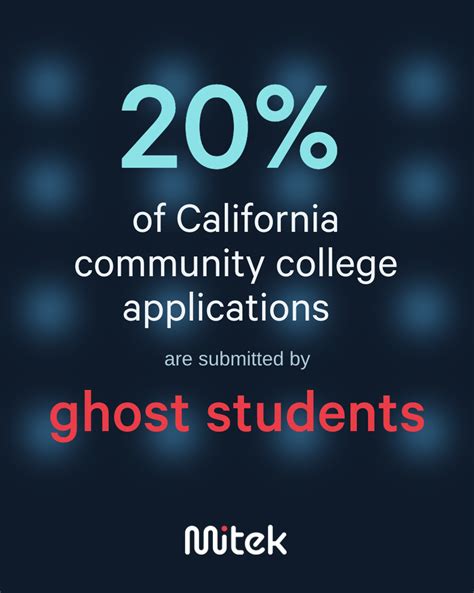
“Ghost students,” or fraudulent enrollments, are costing colleges millions of dollars and displacing legitimate students, as revealed by recent investigations and audits across the United States. These schemes, often involving coordinated networks, exploit vulnerabilities in online education systems to siphon financial aid and tuition revenue, leaving institutions grappling with financial losses and compromised academic integrity.
Ghost Students Drain Millions from Colleges, Displacing Legitimate Learners
Across the United States, a disturbing trend is emerging: “ghost students” are infiltrating college and university systems, pilfering millions of dollars in financial aid and tuition revenue, and preventing genuine students from accessing educational opportunities. Investigations and audits reveal sophisticated schemes exploiting vulnerabilities in online education, particularly in community colleges and smaller institutions, raising serious concerns about the integrity of higher education systems.
The term “ghost students” refers to individuals fraudulently enrolled in courses, often orchestrated by organized networks, with the primary objective of accessing and diverting financial aid funds. These schemes typically involve creating fake student accounts, completing minimal coursework, and then pocketing the financial aid disbursements intended for legitimate students.
“It’s really easy money,” said Scott Schneider, an assistant inspector general for investigations at the U.S. Department of Education Office of Inspector General, highlighting the simplicity with which these schemes can be executed.
The financial impact of these fraudulent enrollments is substantial. While pinpointing the exact amount lost is challenging, investigations have uncovered instances where institutions have lost hundreds of thousands, even millions, of dollars due to ghost student activity. Beyond the direct financial losses, colleges also face the cost of investigations, system upgrades to prevent future fraud, and reputational damage.
Perhaps more concerning is the impact on legitimate students. As ghost students fill up class slots, particularly in high-demand courses, genuine students are denied access to the education they need to progress in their academic careers. This displacement can delay graduation, impact career prospects, and ultimately undermine the mission of higher education.
Modus Operandi: Exploiting Online Vulnerabilities
The rise of online education, while expanding access to learning, has also created new avenues for fraud. Ghost student schemes often target online courses and programs, where it’s easier to create fake identities and conceal fraudulent activity.
The typical modus operandi involves:
- Creating Fake Accounts: Fraudsters use stolen or fabricated personal information to create student accounts, often utilizing email addresses and phone numbers obtained through illicit means.
- Enrolling in Courses: The fake accounts are then used to enroll in courses, particularly those with high financial aid potential.
- Minimal Coursework: Ghost students typically complete minimal coursework, just enough to maintain their enrollment status and continue receiving financial aid disbursements.
- Diverting Funds: The financial aid funds are then diverted to accounts controlled by the fraudsters, often through prepaid debit cards or other untraceable methods.
Several factors contribute to the vulnerability of institutions to these schemes:
- Weak Identity Verification: Many colleges lack robust identity verification processes for online students, making it easier for fraudsters to create fake accounts.
- Inadequate Monitoring: Insufficient monitoring of student activity in online courses allows ghost students to fly under the radar.
- Decentralized Systems: Decentralized financial aid and enrollment systems can make it difficult to detect patterns of fraudulent activity across different departments.
Examples of Ghost Student Schemes Uncovered
Several recent cases illustrate the scope and impact of ghost student schemes:
- Federal Indictments: In June, federal prosecutors in Pittsburgh indicted nine individuals for their roles in a $1.4 million fraud scheme targeting local community colleges. The scheme involved recruiting individuals to pose as students and enroll in online courses, with the promise of sharing the financial aid money. The recruiters allegedly pocketed a significant portion of the funds.
- Miami Dade College Investigation: An internal audit at Miami Dade College uncovered a massive scheme involving hundreds of ghost students. The audit revealed that the college had disbursed millions of dollars in financial aid to fraudulent students, prompting a major overhaul of the college’s enrollment and financial aid processes.
- California Community Colleges: A 2022 state audit of the California Community Colleges system found significant weaknesses in identity verification and enrollment monitoring, making the system vulnerable to ghost student schemes. The audit recommended several measures to strengthen security and prevent future fraud.
These cases are just the tip of the iceberg, according to experts. Many colleges are reluctant to report suspected fraud due to concerns about reputational damage and potential legal liability. This reluctance makes it difficult to assess the true extent of the problem.
Combating Ghost Students: A Multi-Faceted Approach
Addressing the ghost student problem requires a multi-faceted approach involving colleges, government agencies, and technology providers. Key strategies include:
- Strengthening Identity Verification: Implementing robust identity verification processes for online students, such as biometric authentication and knowledge-based authentication, can make it more difficult for fraudsters to create fake accounts.
- Enhanced Monitoring: Utilizing data analytics and machine learning to monitor student activity in online courses can help identify suspicious patterns and flag potential ghost students.
- Centralized Systems: Consolidating financial aid and enrollment systems can improve transparency and make it easier to detect fraudulent activity across different departments.
- Collaboration and Information Sharing: Encouraging collaboration and information sharing among colleges and government agencies can help identify and track organized fraud networks.
- Increased Oversight: Strengthening oversight by state and federal agencies can help ensure that colleges are implementing adequate fraud prevention measures.
- Student Awareness: Educating real students about the dangers of sharing their personal information, which can be used to create fake student accounts, is also important.
The U.S. Department of Education Office of Inspector General (OIG) plays a crucial role in investigating and prosecuting ghost student schemes. The OIG works closely with colleges and law enforcement agencies to uncover fraud and hold perpetrators accountable.
“We are committed to protecting federal student aid programs from fraud and abuse,” said Scott Schneider.
The Future of Higher Education Security
The ghost student phenomenon highlights the need for colleges and universities to prioritize security and fraud prevention in the digital age. As online education continues to grow, institutions must invest in robust systems and processes to protect against fraud and ensure that financial aid resources are used for their intended purpose: to help genuine students access and afford higher education.
Failing to address the ghost student problem will have far-reaching consequences, undermining the financial stability of colleges, compromising academic integrity, and depriving legitimate students of the opportunity to pursue their educational goals.
The battle against ghost students is an ongoing one, requiring constant vigilance and innovation. By working together, colleges, government agencies, and technology providers can create a more secure and equitable higher education system for all.
Frequently Asked Questions (FAQ)
1. What are “ghost students” and how do they operate?
“Ghost students” refer to individuals who fraudulently enroll in college courses, often as part of an organized scheme, with the primary goal of accessing and diverting financial aid funds. They create fake student accounts using stolen or fabricated personal information, enroll in courses (usually online), complete minimal coursework to maintain enrollment status, and then divert the financial aid disbursements to accounts they control. They exploit vulnerabilities in online education systems and weak identity verification processes.
2. How much money have colleges lost due to ghost student schemes?
While the exact amount is difficult to quantify, investigations have uncovered instances where colleges have lost hundreds of thousands, even millions, of dollars due to ghost student activity. A federal case in Pittsburgh involved a $1.4 million fraud scheme, and an audit at Miami Dade College revealed millions of dollars disbursed to fraudulent students. These are just a few examples, suggesting the total losses across the country are significant.
3. How do ghost students affect legitimate students?
Ghost students negatively impact legitimate students by filling up class slots, particularly in high-demand courses. This prevents genuine students from accessing the courses they need to progress in their academic careers, potentially delaying graduation and impacting their future career prospects. It essentially steals educational opportunities from those who deserve them.
4. What measures can colleges take to prevent ghost student schemes?
Colleges can implement several measures to prevent ghost student schemes, including:
- Strengthening Identity Verification: Implement biometric authentication and knowledge-based authentication.
- Enhanced Monitoring: Use data analytics and machine learning to detect suspicious activity in online courses.
- Centralized Systems: Consolidate financial aid and enrollment systems for better transparency.
- Collaboration and Information Sharing: Work with other institutions and government agencies to identify and track organized fraud networks.
- Student Awareness: Educate real students about protecting their personal information.
- Stronger Oversight: Demand better oversight from state and federal regulatory agencies.
5. What role does the U.S. Department of Education Office of Inspector General (OIG) play in combating ghost students?
The U.S. Department of Education Office of Inspector General (OIG) investigates and prosecutes ghost student schemes. The OIG works with colleges and law enforcement agencies to uncover fraud and hold perpetrators accountable, aiming to protect federal student aid programs from fraud and abuse. They investigate and prosecute these crimes to hold those accountable and try to deter others from pursuing such schemes.
In-Depth Analysis
The emergence of ghost student schemes represents a significant threat to the integrity and financial stability of higher education institutions. The shift towards online learning, while offering numerous benefits in terms of accessibility and flexibility, has inadvertently created new vulnerabilities that fraudsters are eager to exploit. The relative anonymity and lack of face-to-face interaction in online courses make it easier for individuals to create fake identities and conceal their fraudulent activities.
The financial incentives for engaging in ghost student schemes are substantial. Financial aid programs, designed to help students afford college, can be a lucrative target for fraudsters who are able to successfully enroll as ghost students. The availability of federal and state grants, as well as student loans, provides ample opportunities for these individuals to siphon off significant sums of money.
Beyond the direct financial losses, the ghost student phenomenon also has a number of indirect costs. Colleges and universities must invest in additional security measures to protect against fraud, diverting resources that could be used for other important initiatives, such as improving academic programs or providing student support services. The time and effort spent investigating and prosecuting ghost student schemes also consume valuable resources.
Moreover, the presence of ghost students can undermine the quality of education for legitimate students. As ghost students fill up class slots, particularly in high-demand courses, genuine students are denied access to the education they need to succeed. This can lead to delays in graduation, reduced career opportunities, and a diminished overall learning experience. The credibility of the institution also suffers when the prevalence of ghost students becomes a topic of concern among the public and prospective students.
Background Information and Expanded Context
The rise of online education has been a transformative force in higher education, expanding access to learning for students of all backgrounds and circumstances. However, this growth has also created new challenges, including the need to protect against fraud and abuse. The ghost student phenomenon is just one example of the ways in which technology can be exploited for illicit purposes.
The problem is exacerbated by the decentralized nature of many college and university systems. Financial aid and enrollment processes are often managed by different departments, making it difficult to detect patterns of fraudulent activity across the institution. Insufficient communication and coordination between these departments can allow ghost students to slip through the cracks.
Furthermore, the pressure on colleges and universities to maintain enrollment numbers can create a perverse incentive to overlook potential fraud. In an increasingly competitive higher education landscape, institutions are often reluctant to reject applications or flag suspicious activity for fear of losing revenue. This can create a climate of complacency that allows ghost student schemes to flourish.
The lack of robust identity verification processes is another contributing factor. Many colleges and universities rely on relatively simple methods of verifying the identities of online students, such as requiring them to submit a copy of their driver’s license or social security card. These documents can be easily forged or stolen, making it relatively easy for fraudsters to create fake student accounts.
Looking Ahead
Addressing the ghost student problem will require a concerted effort from colleges and universities, government agencies, and technology providers. Institutions must invest in more robust security measures, improve communication and coordination between departments, and strengthen identity verification processes. Government agencies must provide greater oversight and support to colleges and universities, helping them to identify and prosecute fraud. Technology providers must develop innovative solutions to detect and prevent ghost student schemes.
In addition to these technical and procedural measures, it is also important to address the underlying factors that contribute to the problem. This includes reducing the pressure on colleges and universities to maintain enrollment numbers, providing greater financial aid to legitimate students, and raising awareness about the dangers of fraud.
By working together, stakeholders can create a more secure and equitable higher education system for all. This will require a commitment to innovation, collaboration, and a relentless pursuit of excellence. The future of higher education depends on our ability to protect against fraud and abuse, ensuring that resources are used to support the education and success of genuine students.
Additional preventative measures colleges can implement:
- IP Address Analysis: Track the IP addresses from which students access online courses. Multiple students using the same IP address from different locations could indicate fraudulent activity.
- Keystroke Analysis: Monitor keystroke patterns for unusual behavior. Fraudsters may use automated tools to complete coursework, resulting in distinct typing patterns.
- Proctored Exams: Require proctored exams for online courses to verify student identity and prevent cheating.
- Regular Audits: Conduct regular internal audits of financial aid disbursements and enrollment records to identify anomalies.
- Background Checks: Perform background checks on individuals who are involved in the financial aid and enrollment processes to prevent insider fraud.
- Fraud Hotline: Establish a fraud hotline where students and employees can anonymously report suspected fraudulent activity.
- Data Sharing Agreements: Establish data sharing agreements with other colleges and universities to share information about suspected ghost students.
By implementing these measures, colleges and universities can significantly reduce the risk of ghost student schemes and protect their financial resources and academic integrity.
The fight against ghost students is not just about protecting money; it’s about preserving the value and credibility of higher education, ensuring that opportunities are available to those who genuinely seek knowledge and advancement.









